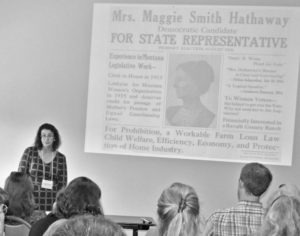
By Michael Howell
“Roots and Branches: 175 Years of Montana History,” that was the theme of the 43rd annual convention of the Montana Historical Society held in Hamilton this year to coincide with the commemoration of the 175th anniversary of the founding of Stevensville, Montana’s first town.
The conference, which stretched over three days, September 22-24, was held at the Bitterroot River Inn where an impressive array of speakers addressed a number of interesting historical topics ranging from Larry Strate’s account of “Mammy” Clara Sarah Smith and the “evening industry” that blossomed in the Bitterroot in the Hamilton’s heyday of development to Dale Burk’s account of the infamous “Clear cut Controversy” that embroiled the Bitterroot and reshaped national timber policy.
People had a chance to hear from Dr. Marshall Bloom and Gary Hettick about “history making” research at the Rocky Mountain Laboratory including a cure for Rocky Mountain spotted fever and the production of a yellow fever vaccine at the lab during WWII that helped the US win the war in the jungles where they were fighting.
Dr. Anya Jabour, professor of history at the University of Montana shared stories about some of Montana’s most significant women reformers, such as Hazel Hunkins, a Billings native who went to federal prison for picketing the White House on behalf of suffrage. Did you know that the when the 19th Amendment to the Constitution was ratified in 1920 guaranteeing women the right to vote that Montana voters approved it by 70% and Ravalli County had the highest approval rating in the state?
There was a lot to learn in many more of the information packed lectures about local and regional history and all the learning was not done in the lecture room. A Made in Montana Tour was offered and participants got a chance to see the valley visiting a three bedroom cottage designed by Frank Lloyd Wright, Rocky Mountain Log Homes, the Rocky Mountain Laboratory, Lifeline Dairy, and Blodgett Canyon Cellars.
There were also a lot of workshops offered for archivists, educators, even gravestone preservationists.
Susan Near, Development and Marketing Director for the Historical Society, said that when planning their conferences, they try to look for local people who are not only knowledgeable about interesting historical subjects but also skilled in presentation.
“We like presentations to be engaging,” she said, “a little more entertaining and less academic than your usual conference presentations, something enjoyable. We try and get good story tellers.”
“With a history so rich, we also try to get a good balance of themes,” she said. “We try to have a lot of diversity in topics.”
Near said that the Montana Historical Society does work hard on collecting and preserving history at the state museum, but also recognizes the importance of public outreach.
“By taking it out on the road, by taking it into the communities, we end up drawing them in,” said Near.
Receiving special awards at the conference were Alfred Wiseman, Nancy Watts, and Evan Barrett.
Wiseman, born and raised in Choteau, has spent his life preserving and sharing Montana’s Metis history. H is sought out by students and scholars for his knowledge. He is recognized for his encyclopedic knowledge and his willingness to share what he knows. He has created traveling trunks that teachers use to bring Metis history alive for their students. He has produced historic maps including one of the Old North Trail corridor along the Rocky Mountain Front. The trail, which stretches from Siberia to Mexico, was used as long as 12,000 years ago. Wiseman was also instrumental in in collecting a treasure trove of oral history as founder of Metis Cultural Recovery, Inc. collecting recording and transcripts with Metis elders. Wiseman received the Heritage Keeper Award at the conference.
Another Heritage Keeper Award recipient was Nancy Watts, who has worked at the Lewistown Public Library for twenty-three years. She worked primarily as a reference librarian, but more recently as Community Preservation Officer and Local Historian. She also volunteers at the Central Montana Historical Museum. She was an early contributor to the Montana Memory Project, a statewide digitization project sponsored by the Montana State Library and the Montana Historical Society.
Recipient of the Heritage Guardian Award was creator of the television series, “In the Crucible of Change: Montana’s Dramatic Period of Progressive Change, 1965-1980. The series featured forty-three hour-long discussions with over seventy-five of the period’s history makers, including former members of the 1972 Constitutional convention, politicians, reporters and judges.
According to former Secretary of State Bob Brown, “Barrett’s knowledge and perspective shine through,” in these, “direct, informative and lively accounts of the history as the participants lived it….”